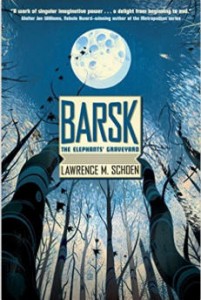My friend Lawrence Schoen’s latest novel and big publisher debut, Barsk: The Elephants’ Graveyard, from TOR Books had sold out its first printing before it even released. It is about sentient animals who have survived the self-destruction of human beings and now rule the galaxy. I asked him to talk on the blog about how to write animals as main characters of a novel.
How do you approach writing animals as characters? Do you anthropomorphize or avoid it?
I treat animal characters much like I treat alien characters, which is to say, I write them as characters first, and then add in the other bits (animal, alien, or both).
I start by asking myself a few basic questions like, “Who is this character? How does he see the world? How does he see himself? What does he want?” and then as these basics start to sketch out, I drop the character into the setting that further shapes those answers.
With the anthropomorphic animal (or as I like to call them, “raised mammals”) characters in Barsk, there were additional factors. The easiest of these was to build on the physiological differences from the source animals, and play with how that then affects the more basic characteristics and questions. This is particularly important for the reader, because she’s looking for something familiar to glom onto, something that can be assessed at a glance, be it an elephant’s trunk or the graceful gait of a cheetah or the relative lethargy of a sloth. These are signals to a reader that say, “oh, okay, it’s like a human being, only not, because it’s also like X.”
After the broad strokes of an animal character is done, the real fun begins. The bits that act as Easter eggs for more savvy readers. Little pieces from research into what ethologists and other scientists have learned about these species which when dropped into sapient characters inform their culture and worldview. As one example, we know that among elephants, after a certain age, the males all go off on their own solitary way and only return to mate, leaving the females behind to form groups of adults and children of both sexes. Take this one datum and apply it a planet of uplifted elephants and you get a society where you have households of adult females — mothers and sisters aunts and cousins, like something out of H.M.S. Pinafore — taking responsibility for all child rearing, and males who spend their adult lives as peripatetic bachelors — never settling down for long, always moving on. And from there you get to ask how this all manifests in routine things that you probably won’t actually look at in the book, but which has to exist in the back of your mind because it all influences the way the characters walk through their own world. Questions like, “What does this do to the housing market? What’s the impact on job security? What happens to individuals who don’t fit smoothly into the society’s normative roles?”
The characters in an anthropomorphic novel need to have the same quality of breadth and depth and variety that ordinary human characters enjoy and/or endure; it’s all just filtered through the specialized animal traits that is their due as well. Because at the end of the day, you’re using them to tell human stories, and while they may be furry or horned or bat-winged or something else, they must also project a basic humanity, one to which the reader can relate. In the end, the thing we always remember about the best alien or anthropomorphic characters isn’t how much they differ from us, but how human they were.
Lawrence M. Schoen holds a Ph.D. in cognitive psychology and psycholinguistics. He’s also one of the world’s foremost authorities on the Klingon language, and the publisher of a speculative fiction small press, Paper Golem. He’s been a finalist for the John W. Campbell Award, the Hugo Award, and the Nebula Award. Lawrence lives near Philadelphia. You can find him online at LawrenceMSchoen.com and @KlingonGuy.

